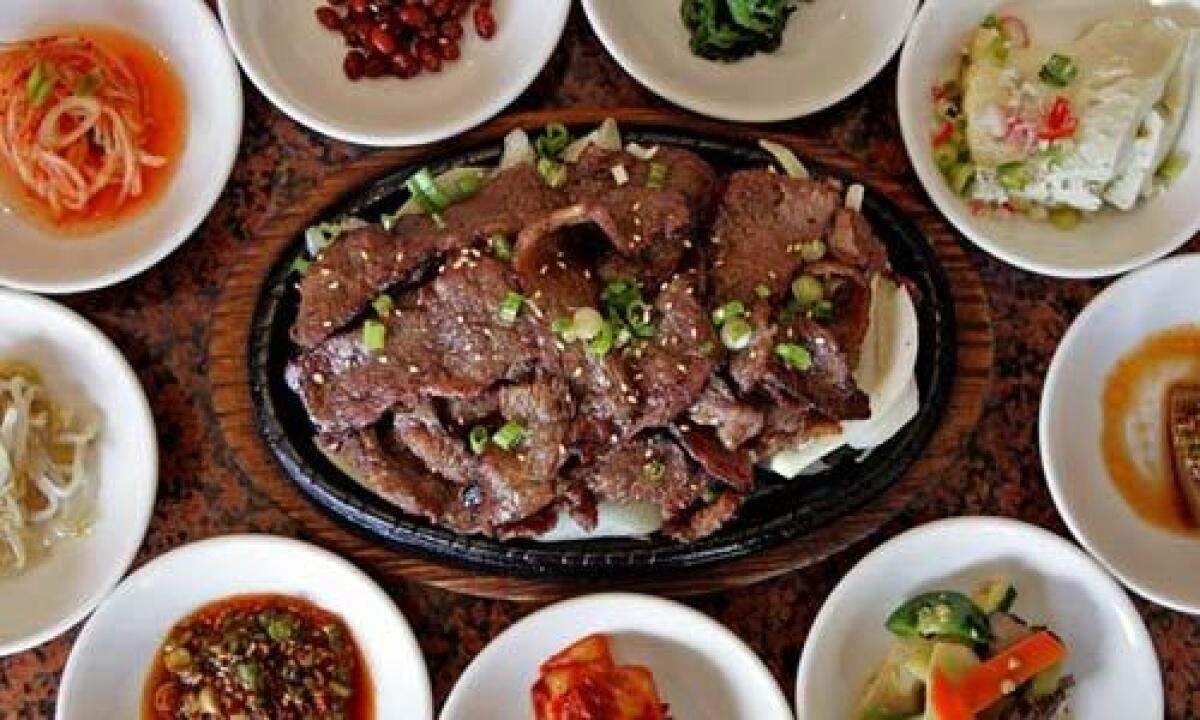The Find: Seongbukdong in Koreatown

- Share via
This is how to experience the essence of pure Korean funk: First, take mackerel, queen of the powerful, oily fishes. Then add special kimchi, long-fermented for extra pungency, and some heavily fermented soy sauces. Simmer together carefully, until the mixture becomes a glowing, red syrup.
This is not for the weak-hearted. It’s for lovers of intense flavors -- for lovers of blue cheese, Belgian beer and long-cured sausage.
Braised mackerel is the specialty of the house at Seongbukdong, a tiny, neat restaurant on the edge of Koreatown. It happens to be one of the few specialists in Gyeonsang-style country cooking in the neighborhood.
If you wander into Seongbukdong and casually order some Korean standbys -- barbecue pork, stone pot bibimbap (rice bowl) -- you will have failed to experience the true Seongbukdong. These standards are perfectly tasty, but just look around. Notice the same battered silver bowl on every table, full of red mackerel. Notice the Korean-language newspapers on the wall, all featuring pictures of the same grandmotherly Korean woman, holding out bowls of all sorts of mysterious, reddish and brownish liquids. This is not a barbecue house; this is a house of stew and soul.
The kindly-looking woman featured in those newspaper articles is Young-hee Shon. She was a housewife in Seong Buk Dong, a neighborhood of Seoul, and the source of her restaurant’s name. But her cooking is pure Gyeongsang -- the province in South Korea where she was born and raised. When she came to Los Angeles 22 years ago, she started working in various Koreatown restaurants. But, she found, no restaurant captured the particular tastes of Gyeongsang.
Gyeongsang cooking, like much of the cooking from the warmer regions of southern South Korea, is bolder and saltier than other Korean cooking, says Shon.
The braised mackerel is a product of Shon’s devotion to ingredients, time and the art of fermentation. She uses carefully sourced Norwegian mackerel, and three distinct forms of fermented goodness. There’s the specially fermented soy sauce that she makes herself, and the separately fermented soy-chile sauce. Most important, there’s the house-made kimchi, aged extra-long in the Gyeongsang style, at least six months.
The mackerel is served in a battered silver bowl -- in honor of the old, impoverished days, Shon says. “Back then in the country, everything was organic,” she says.
House-made panchan -- the spread of little dishes that accompanies any Korean meal -- shows off more of Shon’s care. They change with the seasons, as they do at any sincere Korean restaurant. But, if you’re lucky, the spread will include big cubes of ggakdugi -- pickled daikon. Shon’s pickled daikon is profound. It has both the Champagne-like, bubbly pickly-ness of carefully made kimchi and the majestic ripeness of a really great Stilton. It resonates with life, love and age.
The secrets of her cooking, Shon says, are quality and careful preparation.
Take gook bab, called beef-rice soup on the menu, a humble-looking soup of beef bits and vegetables, meant to be combined with rice at the table. She puts high-quality short ribs, center heel shanks and tendon into it, and simmers them for hours. The daikon is cut on a bias, just the way it was done in the old country, she says. Those fascinatingly textured bits of meaty vegetables? That’s Korean taro stem. The soup is deep and clarifying.
Her bean paste casserole is also a must-eat. This is a soup heavily dosed with doenjang -- Korean fermented bean paste. Her doenjang is another fine example of the Gyeongsang affection for direct, chunky flavors. The doenjang of Seoul is a mild creature, Shon says. “For us [from Gyeongsang], doenjanghas a good saltiness to it.”
The top three items at her restaurants, Shon will say immediately, are braised mackerel, gook bab and steamed beef short ribs. It’s a good trinity to order together -- the oily punch of mackerel, the cleansing simplicity of the beef-rice soup.
Steamed beef short ribs are a simple, sweet comfort: big chunks of beef, with excellently gelatinous bits of tendon stripped from the bone, and steamed into wonderful tenderness. It’s warming -- the charming sister with the nice smile who’ll hold your hand and comfort you after you’ve been beaten up by the salty mackerel sister.
For some folks, it’s about as utterly pleasurable as meat can get -- soft beef candy, basically. Be sure to dig through the pile of beef with your spoon, and swish every chunk in the extra-sweet, extra-beefy syrup at the bottom of the bowl.
More to Read
Eat your way across L.A.
Get our weekly Tasting Notes newsletter for reviews, news and more.
You may occasionally receive promotional content from the Los Angeles Times.










